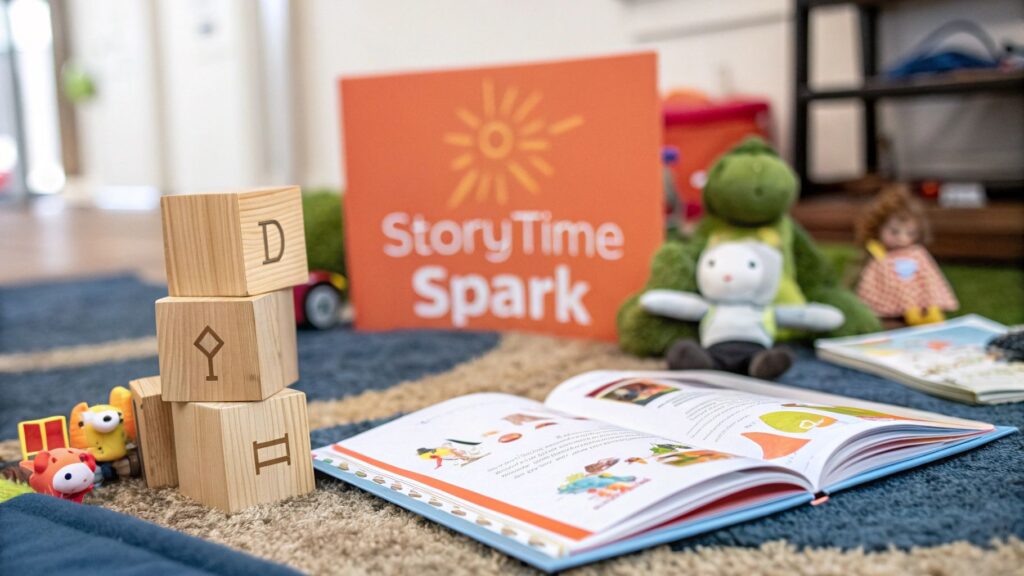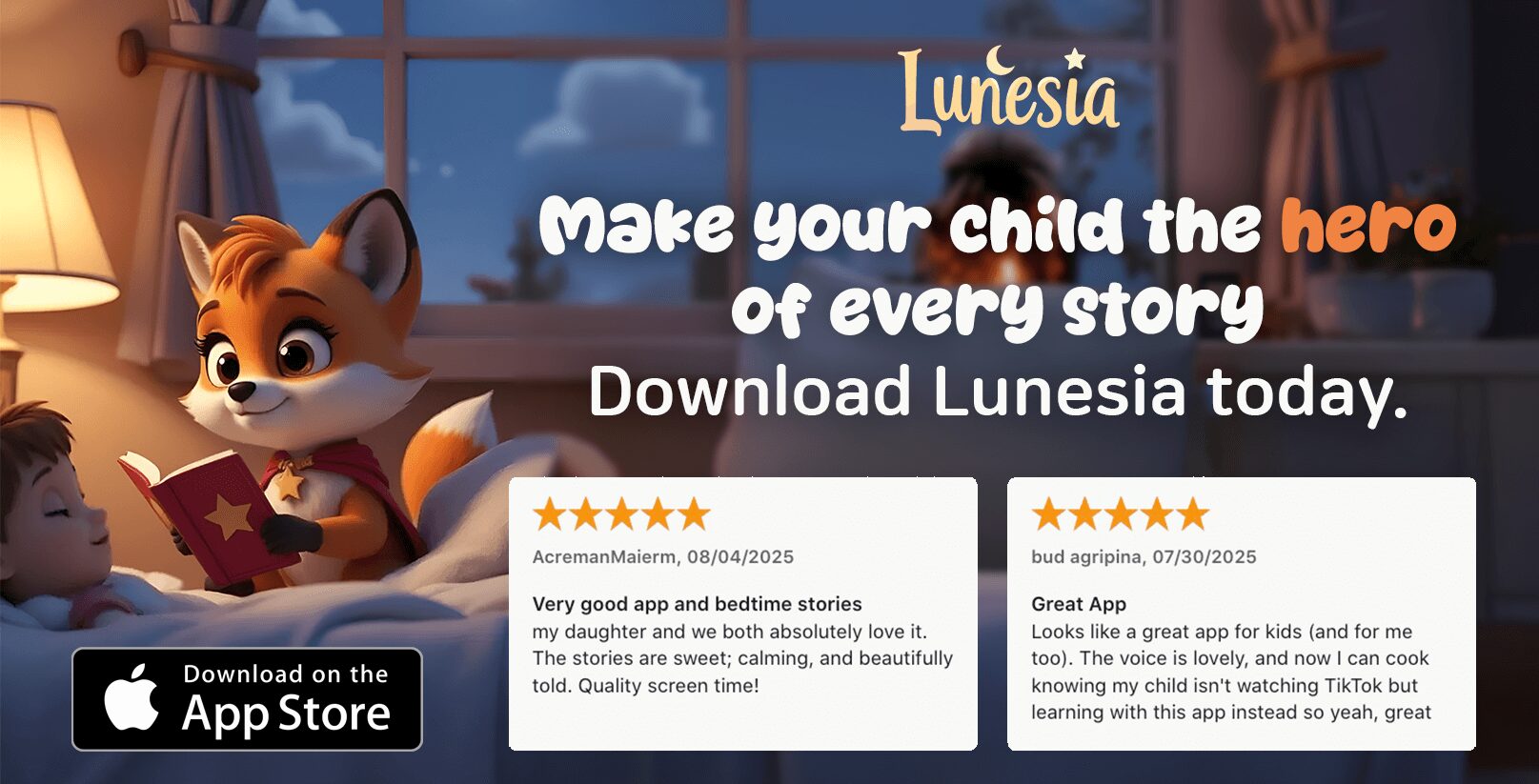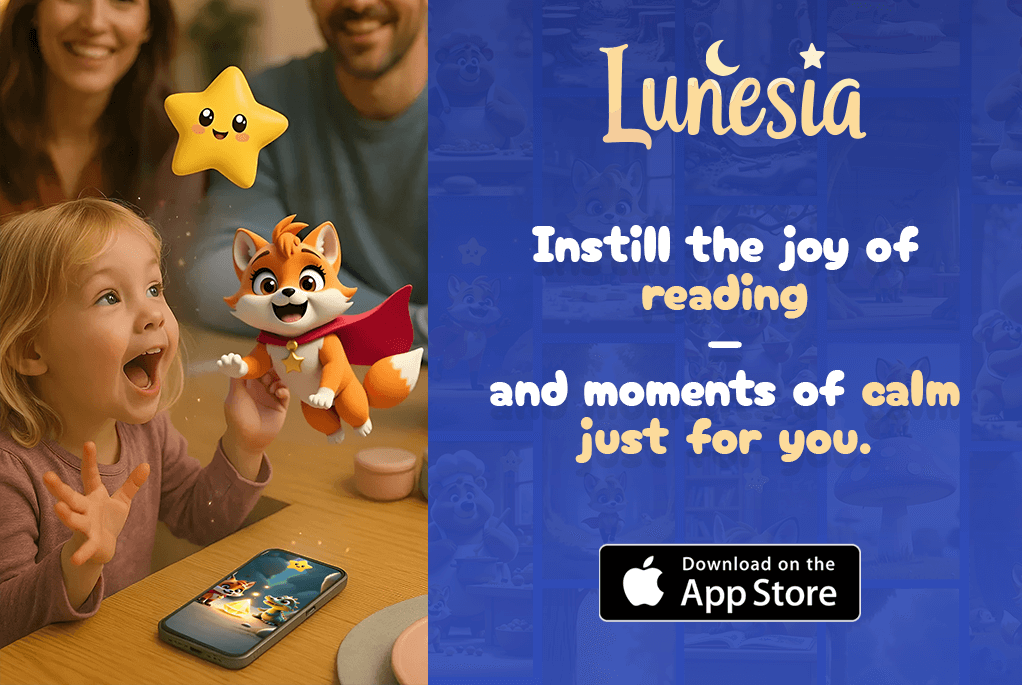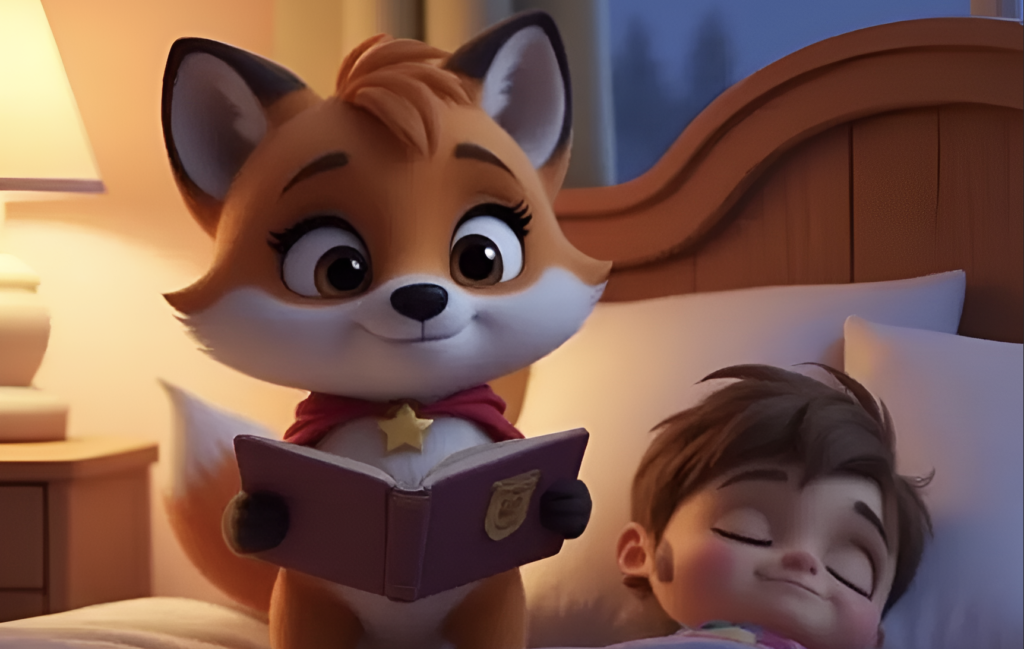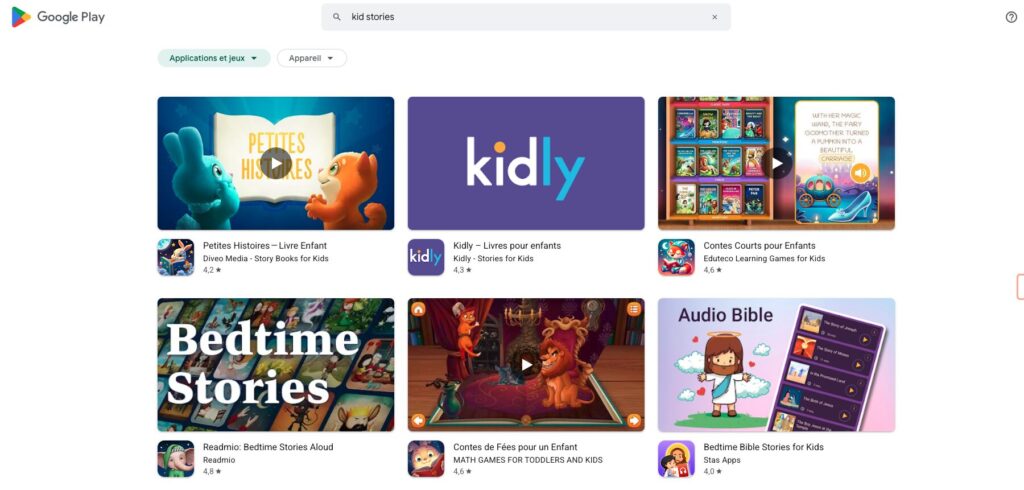Remember that feeling of being completely lost in a story? That magical, world-building power is one of the greatest gifts we can give our children. But in a world of endless distractions, how do you spark that fire? What if the secret isn't just about reading more books, but about turning storytelling into a genuine adventure your child can lead?
You're juggling a million things, and you need solutions that work, not just theories. So let's skip the generic crafts. We've gathered 8 parent-tested, brain-boosting storytelling activities for preschoolers that turn everyday moments into epic tales. These methods are designed to build crucial language and emotional skills, and maybe even give you back a few precious minutes of peace.
Did you know that beyond just fostering imagination, a great story can be the perfect wind-down tool? Exploring how reading can contribute to a restful night shows just how powerful narrative is for creating calm. In this guide, we'll cover hands-on, screen-free ideas and also show you how technology, when used thoughtfully, can unlock a new universe of interactive learning where your child is the hero. Let's dive in.
1. Story Stones: Building Tales, One Pebble at a Time
Have you ever wished you could hand your child a box of inspiration? That’s exactly what story stones are. Imagine a collection of smooth, simple pebbles decorated with images—a sun, a boat, a friendly whale. Suddenly, these aren't just rocks; they're the building blocks for an incredible adventure waiting to be told.
Why do these work so well? Story stones are one of the most effective storytelling activities for preschoolers because they are inherently child-led. A child might pick up a stone with a shining sun, then one with a little boat, and finally one with a friendly whale. Instantly, a story is born about a sunny day at sea and a brand new ocean friend. There's no pressure of a blank page, just the simple joy of creating.
How to Make Story Stones Work for You
Getting started is simple, and the benefits are immense. This tactile approach helps children grasp concepts like sequence (beginning, middle, and end) while boosting their vocabulary and confidence.
- Start Small: Got a two-year-old? Begin with just 5-6 stones to avoid overwhelming them. Focus on familiar images like a house, a child, a dog, a tree, and a moon.
- Model First: Show them how it’s done! Create a very simple story yourself. "Once, a little dog lived in a house. One night, he looked up at the moon and decided to go for an adventure."
- Create Themed Sets: Is your little one obsessed with dinosaurs? Or maybe space? Align the stones with topics they love. This is a common practice in Head Start programs to build topic-specific vocabulary.
- Make it a Group Activity: At a playdate? Encourage turn-taking where each person adds one stone and the next part of the story. This builds collaborative and listening skills.
Pro-Tip: Seal your painted or drawn stones with a non-toxic varnish. This makes them durable enough to last through countless story sessions, whether indoors or out in the garden. Forest schools often create their stones with natural materials, connecting storytelling directly to the environment.
2. Puppet Theater Storytelling: Giving Voice to Imagination
What if your child could literally become the hero of their own story? With puppet theater, they can. This classic activity involves using hand puppets, sock puppets, or even simple paper creations to act out stories, turning preschoolers into directors, actors, and creators all at once.
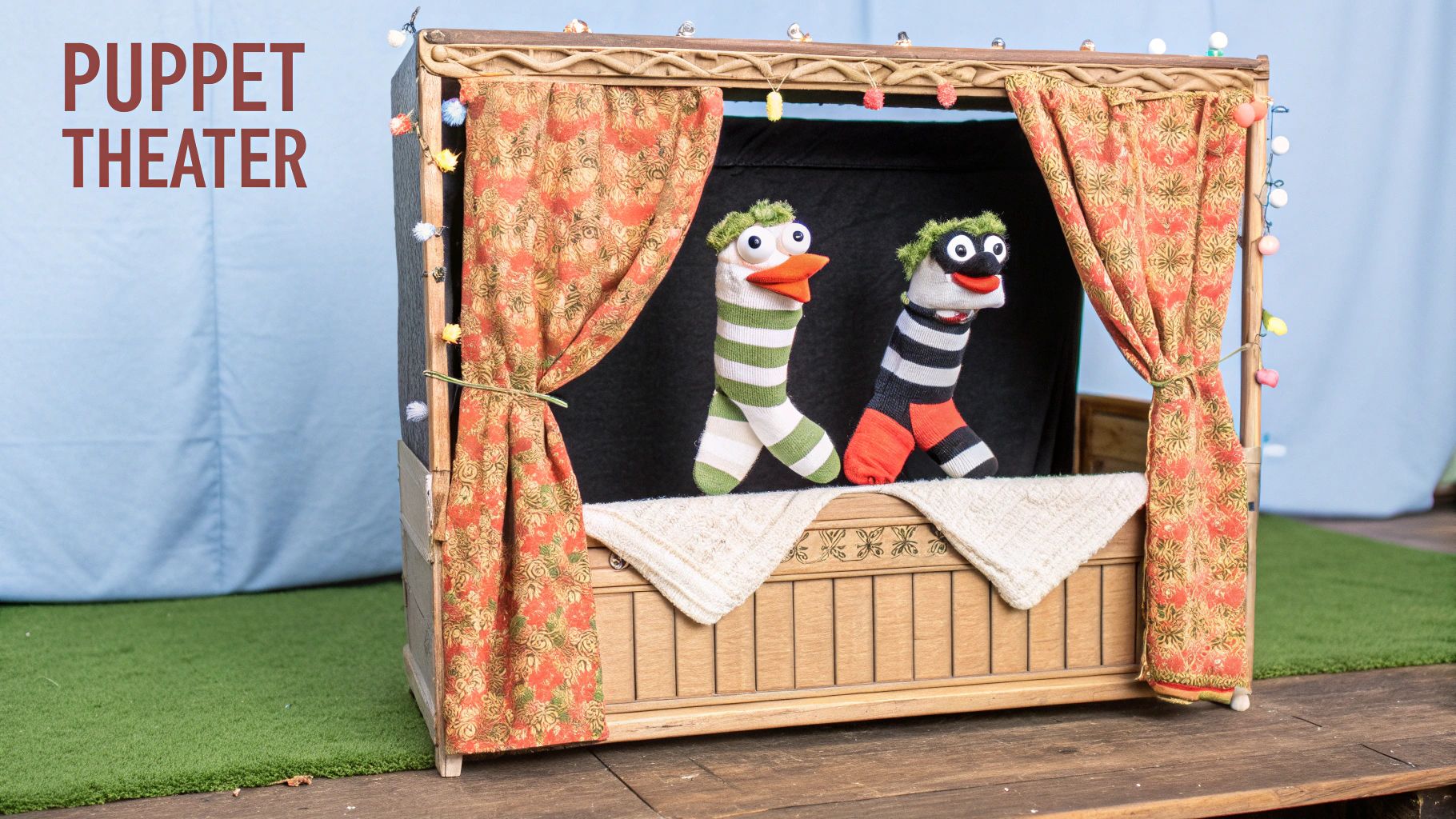
Puppet theater is one of the most powerful storytelling activities for preschoolers because it provides a safe space for emotional exploration. As Fred Rogers masterfully showed us, a puppet can express feelings a child might be hesitant to share on their own. Is your child feeling anxious about starting school? A puppet can voice that fear. Worried about a monster under the bed? A brave puppet can face it. It's a gentle way to practice dialogue, empathy, and problem-solving.
How to Make Puppet Theater Work for You
Setting up a stage, even a simple one behind a couch, transforms your living room into a world of possibility. This activity is fantastic for boosting public speaking confidence and understanding character perspectives.
- Start with Simple Creations: You don't need fancy puppets. Create your own simple sock puppets or decorate paper bags. The act of creating the character first gives your child a deeper connection to the story.
- Retell Familiar Tales: Begin with a story your child knows well, like "Goldilocks and the Three Bears." This provides a narrative framework, allowing them to focus on dialogue and action without the pressure of inventing a plot from scratch.
- Establish a "Backstage": Designate a small area where kids can prepare their puppets and story ideas. This simple boundary adds a sense of professionalism and helps focus their creative energy.
- Work in Pairs or Groups: Encourage siblings or friends to put on a show together. This fosters crucial collaboration, listening skills, and the ability to build on another person’s ideas.
Pro-Tip: Use puppets as a tool for social-emotional learning. A puppet can help mediate a disagreement between siblings or introduce a conversation about a tricky emotion, like jealousy or fear, in a gentle and approachable way.
3. Picture Card Sequencing
What if you could give your child a jumbled story and watch them become the detective who puts it all back together? Picture card sequencing hands them this power, using a set of illustrated cards that show different parts of a narrative. Their mission is to arrange them in the correct order, turning chaos into a coherent tale.
Why does this work so beautifully? This method is one of the most powerful storytelling activities for preschoolers because it directly teaches the logic of a story. By physically arranging the cards, children grasp foundational concepts like “first, next, and last” and see how one event leads to another. Research shows this ability to sequence is a key predictor of later reading comprehension.
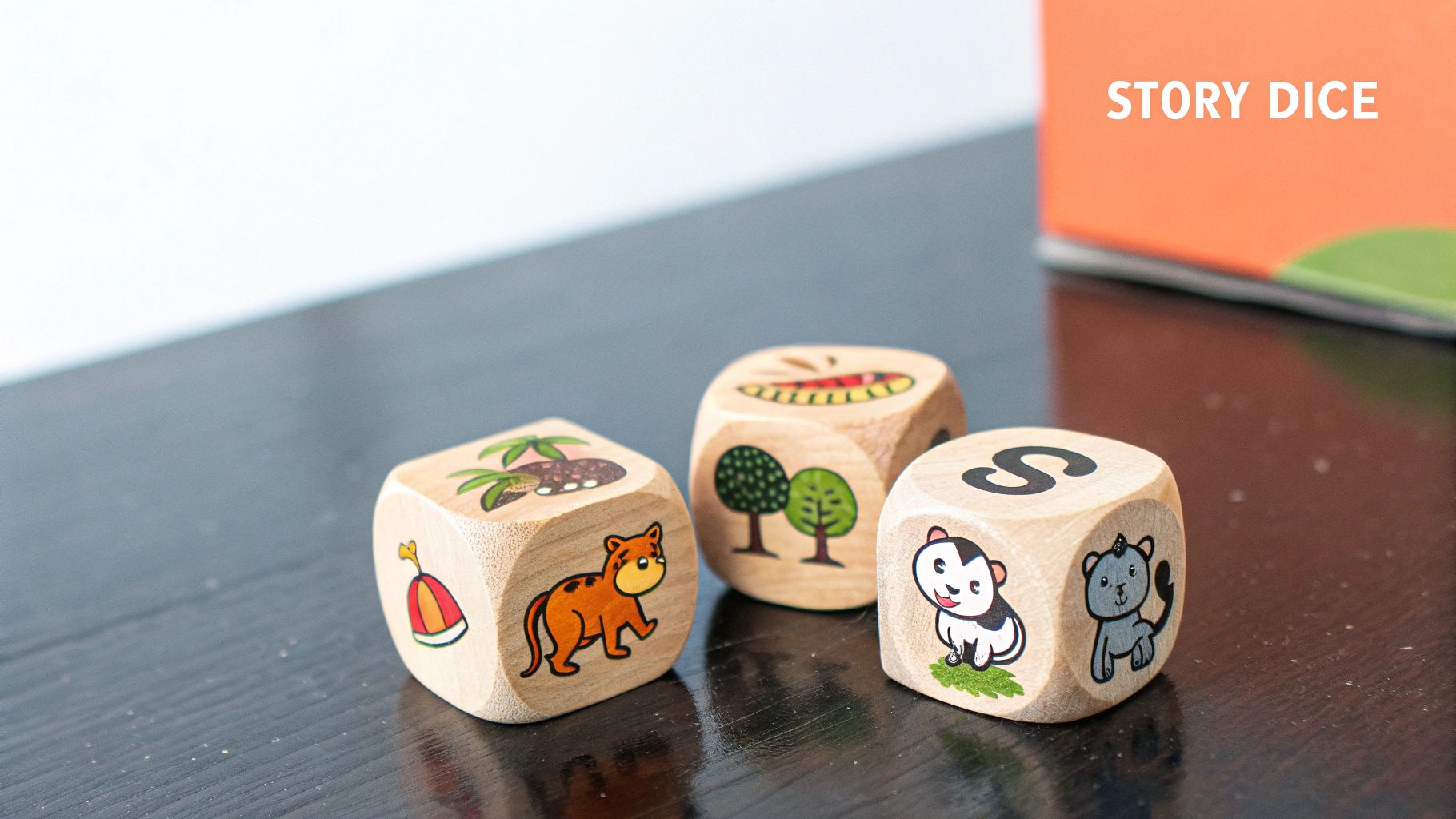
How to Make Picture Card Sequencing Work for You
Getting started with sequencing is a fantastic way to develop your child’s narrative and organizational skills. This visual activity helps them predict outcomes, understand cause and effect, and articulate their thoughts clearly.
- Start Simple: Begin with a 3-card sequence to introduce the concept without causing frustration. A classic example is: a seed, a sprout, and a flower.
- Use Familiar Stories: Create card sets based on books they adore, like The Very Hungry Caterpillar. This leverages their existing knowledge and builds confidence.
- Verbalize the Story: After they arrange the cards, ask them to tell you the story. Prompt them with questions like, "What happened first?" and "Then what happened to the little boy?"
- Make it Personal: Create custom sequences with photos from their daily life. Pictures of waking up, eating breakfast, and brushing teeth make the abstract concept of time tangible and relevant. This is a common practice in Montessori classrooms to connect learning to practical life.
- Build Independence: Number the backs of the cards so children can flip them over to check their own work. This is a great feature for quiet-time learning centers and helps foster self-correction.
Pro-Tip: Laminate your picture cards for durability. Speech-language pathologists often use laminated, high-contrast cards because they withstand repeated use in therapy sessions designed to build language and narrative skills. This simple step makes your sets last for years.
4. Story Dice Rolling: Let Chance Create the Tale
What if you could turn storytelling into an exciting game of chance? Story dice do just that, using illustrated cubes to generate random, unpredictable prompts for new adventures. A roll of the dice might reveal a key, a climbing vine, and a happy frog, instantly sparking a tale of a hidden treasure found by an adventurous amphibian.
This game-like approach is one of the most playful storytelling activities for preschoolers because it removes the pressure of coming up with ideas from scratch. There's no right or wrong answer, only a fun puzzle to solve. For a child who might feel anxious about making decisions, this provides a gentle framework, much like how apps like Lunesia offer choices within a story to build confidence in a safe, guided environment where children learn that their choices matter.
How to Make Story Dice Work for You
Getting started is as simple as a roll, and the benefits for creative thinking and problem-solving are immediate. This activity encourages children to find connections between unrelated objects, a key component of imaginative thinking.
- Start with Fewer Dice: Begin with just 2-3 dice for younger children. This keeps the task manageable and builds confidence. "You rolled a rocket and a cake! Did the astronaut bring a birthday cake to the moon?"
- Model the Connections: Show your child how to link the images into a narrative. Roll the dice yourself and think out loud, demonstrating how to weave the pictures into a beginning, middle, and end.
- Create Your Own: Don't have a set? Make your own! Use wooden blocks and stickers or draw simple pictures on large foam dice. This allows you to create themed sets that align with your child’s current interests, from dinosaurs to deep-sea creatures.
- Pair with Drawing: After the story is told, invite your child to illustrate it. This deepens their connection to the narrative they created and reinforces the story's sequence.
Pro-Tip: Use story dice during transition times, like waiting for dinner or during a car ride. The compact, screen-free nature of the game makes it a perfect tool to turn a moment of boredom into a burst of collaborative creativity and connection.
5. Felt Board Storytelling: A Tactile Theater of Tales
What if your child could not only hear a story but also touch and move its characters? Felt board storytelling transforms a simple fabric-covered board into a dynamic stage where characters, objects, and scenery come to life. This classic, hands-on activity uses the natural friction of felt pieces to create a vibrant, interactive narrative that can be changed in an instant.
Felt board storytelling is one of the most beloved storytelling activities for preschoolers because it makes stories concrete and visual. As a child places a felt sun in the sky or moves a little sheep across a green hill, they are physically engaging with narrative elements. This method, a staple in Waldorf education and public library story times, empowers children to direct the action, boosting comprehension and making them active participants rather than passive listeners.
How to Make Felt Board Storytelling Work for You
Bringing this tactile theater into your home is simple and fosters deep engagement. This approach is fantastic for helping children understand story structure, character roles, and setting, all while they play.
- Start with Rhymes: Use the felt board to illustrate familiar songs and rhymes like "Twinkle, Twinkle, Little Star" or "Five Little Ducks." This builds a bridge between music, language, and visual representation.
- DIY Your Set: You don't need to be an artist. Trace simple shapes onto felt for characters and scenery. Involving your child in creating the pieces adds another layer of ownership and excitement to the activity.
- Empower Independent Play: Once introduced, place the felt board in a literacy or play corner. Children will naturally gravitate towards it, using the pieces to retell known stories or invent entirely new worlds on their own. This independent creation is a powerful form of self-expression.
- Store Stories Simply: Keep all the felt pieces for a single story together in a labeled envelope or zip-top bag. This makes it easy for your child to grab a complete "story kit" and start creating instantly.
Pro-Tip: Make your felt board portable for storytelling on the go. Cover the inside of a pizza box or a large file folder with a piece of felt. You can store the story pieces inside, creating a self-contained, travel-ready activity perfect for waiting rooms or quiet time.
6. Lunesia's Interactive Stories: Where Your Child is the Hero
What if screen time could transform your child from a passive viewer into the hero of their own adventure? That's the power of thoughtfully designed interactive stories. Imagine an app where your child doesn't just listen to a story, but makes decisions that shape the entire journey—teaching them kindness, courage, and problem-solving along the way.
This is exactly what Lunesia does. It’s not just another set of bedtime stories; it's a collection of value-rich quests where choices matter. When a character is scared, does your child choose to comfort them or run away? This active participation is one of the most powerful storytelling activities for preschoolers because it builds empathy and emotional resilience in a safe, ad-free environment. While they’re immersed in a meaningful adventure, you gain precious, guilt-free time for yourself, knowing they're learning and safe.
How to Make Interactive Storytelling Work for You
Introducing technology this way amplifies a child's natural desire to explore cause and effect. It's a modern way to build timeless values.
- Co-Play First: Explore an interactive story together the first time. Talk about the choices. "Why do you think helping the little fox was a good idea?" This models critical thinking.
- Connect to Real Life: Did a story teach a lesson about sharing? Talk about it later at the playground. "Remember how the characters in Lunesia shared their magic berries? Maybe we can share the swing."
- Set the Scene for Calm: Use these stories as a positive wind-down activity before bed. The engaging, gentle narratives are perfect for transitioning from a busy day to a peaceful night.
- Empower Their Choices: Celebrate the decisions your child makes within the story. This validation reinforces their confidence and shows them that their perspective has a real impact on the world around them.
Pro-Tip: Look for stories that specifically address common childhood challenges like fears, anxieties, or handling big emotions. A 2021 study showed that children who engage with prosocial digital media demonstrate higher levels of empathy. Lunesia is designed to do just that, giving your child a "practice run" for real-life emotional challenges.
7. Story Retelling with Props Box
What if your child could literally step into their favorite story? A story props box makes this possible by providing a curated collection of three-dimensional objects and costumes that bring a specific narrative to life. This hands-on method transforms storytime from a passive listening activity into an interactive, theatrical performance.
This is one of the most powerful storytelling activities for preschoolers because it connects language to action. After hearing a story like The Three Bears, a child can pick up a small, medium, and large bowl, sit in different-sized chairs, and act out the scenes. This multisensory approach cements comprehension and sequencing, making abstract plot points concrete and memorable.
How to Make a Props Box Work for You
Assembling a props box is a creative activity in itself, and its use deeply supports literacy and imaginative play. It empowers children to retell stories in their own words, boosting their confidence and narrative skills.
- Start with the Classics: Begin with simple, familiar tales that have clear characters and props. The Three Little Pigs (straw, sticks, bricks), Goldilocks and the Three Bears (bowls, spoons, small blankets), or The Gingerbread Man are perfect starting points.
- Include the Book: Always place a copy of the book or laminated story sequence cards inside the box. This provides a visual reference that helps children stay on track with the narrative.
- Involve Your Child: Turn prop creation into an art project. Let your preschooler help paint cardboard props, find "treasures" in the backyard, or choose costumes. This builds ownership and excitement for the story.
- Model the Play: The first time you introduce a box, act out the story with them. Use silly voices for the characters and exaggerate your actions. Show them how to use the props to move the story from beginning to end.
Pro-Tip: Use clear plastic bins for your props boxes so children can see the contents at a glance. On the lid, tape a photo inventory of everything that belongs inside. This visual checklist makes cleanup a simple matching game and teaches organizational skills.
8. Collaborative Story Building Circle: Weaving a Story Together
What if a story wasn't something you just read, but something your whole family built together, piece by piece? That’s the magic of a collaborative story circle, a dynamic group activity where each person adds a sentence to create a one-of-a-kind narrative. This simple game transforms storytelling from a passive to an active, social experience.
The collaborative story circle is one of the most powerful storytelling activities for preschoolers because it fosters crucial social skills like listening and turn-taking. When a special "story stick" is passed to a child, they add the next line. They might hear, "Once upon a time, a little frog lost his favorite red boot…" and add, "…so he decided to ask the wise old owl for help." The story grows organically, driven by the group's collective imagination.
How to Make a Story Circle Work for You
Getting started is as easy as gathering in a circle, and the rewards are profound. This activity builds confidence, promotes verbal expression, and teaches children that their voice is a valuable part of a larger creation.
- Start with a Strong Opener: Give the story a clear direction. A great beginning like, "One chilly morning, a brave little squirrel peeked out of its nest and saw something sparkling on the ground…" provides a solid foundation for others to build upon.
- Use a Talking Object: Pass around a special item, like a soft toy or a decorated "story stick." Only the person holding the object can speak. This simple rule prevents interruptions and ensures everyone gets a turn.
- Scribe the Story: Write the story down on a large piece of paper as it unfolds. Seeing their spoken words turned into written text is incredibly empowering for preschoolers and reinforces early literacy connections.
- Read it Aloud: When the story is finished, read the entire creation back to the group with dramatic flair. Celebrating the finished product gives everyone a sense of shared accomplishment and pride. This group-focused activity is a fantastic way to build community, much like the shared decision-making in Lunesia’s interactive stories.
Pro-Tip: Keep the group small (5-8 children) to maintain engagement and ensure everyone gets multiple turns. Educators like Vivian Gussin Paley championed this method to show children how their ideas can come together to form a beautiful, coherent whole.
Storytelling Activities Comparison Table
| Method | Implementation Complexity 🔄 | Resource Requirements ⚡ | Expected Outcomes 📊 | Ideal Use Cases 💡 | Key Advantages ⭐ |
|---|---|---|---|---|---|
| Story Stones | Moderate (painting/sealing stones) | Low (stones, paint, sealant, storage) | Creativity, narrative skills, sequencing | Small groups, tactile learners, flexible stories | Engages multiple learning styles, portable |
| Puppet Theater Storytelling | Moderate to High (space, puppet care) | Moderate (puppets, stage, props) | Expressive language, social-emotional skills | Dramatic play, group performances, dialogue | Builds confidence, reduces performance anxiety |
| Picture Card Sequencing | Low to Moderate (card preparation) | Low (printed/laminated cards, storage) | Temporal reasoning, logical thinking, sequencing | Independent or collaborative narrative building | Clear visual scaffolding, assess comprehension |
| Story Dice Rolling | Low (dice use, minimal prep) | Low to Moderate (dice sets) | Creative thinking, flexible storytelling | Game-like play, spontaneous story creation | Removes blank page anxiety, highly engaging |
| Felt Board Storytelling | Moderate to High (creating pieces) | Moderate (felt board, felt pieces) | Comprehension, engagement, interactive story | Teacher-led or child-directed storytelling | Highly visual, reusable pieces, hands-on |
| Lunesia's Interactive Stories | Low (download and play) | Moderate (device, subscription) | Empathy, decision-making, emotional resilience | Quiet time, travel, bedtime wind-down | Guilt-free screen time, builds values, zero prep |
| Story Retelling with Props Box | Moderate (collecting props) | Moderate (props, costumes, storage) | Comprehension, sequencing, oral language | Dramatic play centers, story reenactment | Concrete storytelling, kinesthetic engagement |
| Collaborative Story Building Circle | Low (facilitation needed) | Very Low (talking stick, paper, markers) | Social skills, turn-taking, creativity | Whole or small group storytelling | No materials needed, builds community |
Your Story Begins Now: From Listener to Leader
We’ve journeyed through a world of imagination, from hand-painted story stones to the vibrant glow of a digital adventure. Each of these storytelling activities for preschoolers, whether it’s the tactile joy of a felt board or the collaborative energy of a story circle, serves a purpose far greater than simple entertainment. They are foundational exercises in building a resilient, creative, and emotionally intelligent child.
You've seen how simple props can unlock complex narratives and how rolling a die can teach cause and effect. These activities are your toolkit for transforming passive listening into active participation. They empower your child to move from a consumer of stories to a confident creator, a leader in their own imaginative world.
The Lasting Impact of Shared Stories
The true magic of these activities isn't just in the moments of play. It's in the lasting skills they cultivate. When your preschooler decides what happens next to the puppet, they are practicing critical thinking and problem-solving. When they arrange picture cards to form a logical sequence, they are building the very framework for literacy and comprehension.
More importantly, these shared storytelling moments build a profound emotional connection. You're not just telling a story; you are co-creating a memory. This dedicated time sends a powerful message: "Your ideas matter. Your feelings are valid. Your voice is important." This validation is the bedrock of self-esteem and emotional security, providing a safe space for them to explore big feelings like fear, joy, or frustration.
Your Actionable Next Step: Start Small, Dream Big
Feeling inspired but not sure where to begin? Don't try to do everything at once. Your goal is integration, not overwhelm.
- Pick one activity that resonated with you. Was it the simplicity of story stones? Or the organized fun of a prop box? Choose the one that feels most achievable for your family this week.
- Schedule a 15-minute "Story Time" into your routine. It doesn't have to be a major production. Consistency is far more powerful than complexity. A short, focused session after dinner or on a Saturday morning can become a cherished ritual.
- Embrace the imperfection. The stories will be silly, nonsensical, and beautifully chaotic. That's the point! Your role is to be an enthusiastic audience and gentle guide, not a director. Celebrate their creativity, no matter how wild the tale becomes.
By weaving these storytelling activities for preschoolers into your daily life, you are doing more than just teaching language skills. You are nurturing a future innovator, a compassionate friend, and a resilient problem-solver. You are handing them the pen and showing them that the most exciting chapter is the one they write themselves.
Ready to unlock a universe of interactive adventures without the prep work? Lunesia offers a library of immersive stories where your child makes decisions that shape the outcome, teaching kindness, courage, and empathy in a safe, ad-free environment. Give your child the gift of becoming the hero and claim your precious guilt-free time today.
